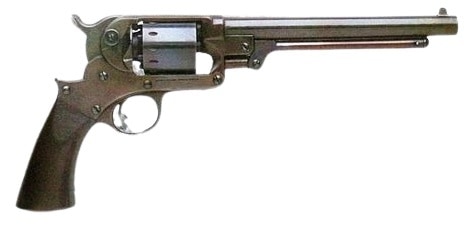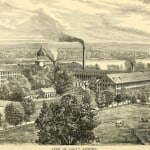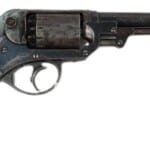
Introduction
The American Civil War was a proving ground for firearms innovation, a time when manufacturers fought not only on battlefields but also in factories, pushing the limits of technology to supply the Union and Confederate forces with reliable weaponry. Among the pantheon of Civil War revolvers, one name often takes a backseat to the likes of Colt and Remington—but should not be overlooked. The 1863 Starr Army Revolver, a robust and highly serviceable firearm, played a vital role in arming Union forces and remains a fascinating artifact of 19th-century firearms engineering.
The Origins of Starr Arms and Its Inventor
The Starr Arms Company was founded by Eben T. Starr, a prolific firearms designer whose vision led to several innovative revolver designs. The company, originally based in Binghamton, New York, later moved its primary manufacturing operations to Middletown, Connecticut, where it produced some of the most sophisticated percussion revolvers of the era.
Starr was not merely a businessman—he was an inventor, securing multiple patents for firearm mechanisms. His designs were engineered for military use rather than civilian sales, making the company a crucial supplier to the Union Army. The earlier Model 1858 Starr double-action revolver, while advanced for its time, was met with skepticism by troops who found its mechanism complex and prone to fouling in the field. This led to the development of a simplified, more rugged design: the Model 1863 Starr Army Revolver.
The 1863 Starr Army Revolver: Technical Breakdown and Innovations
Caliber, Barrel, and Firepower
The Model 1863 Starr Army Revolver was a .44 caliber percussion revolver, designed to fire either a round ball or a conical bullet, both propelled by black powder and ignited via percussion caps. This placed it in direct competition with the Colt 1860 Army and Remington New Model Army, two of the most widely issued Union sidearms.
- Barrel Length: 8 inches
- Overall Length: Approximately 13.5 inches
- Weight: Around 3 lbs, 2 oz
- Cylinder Capacity: Six-shot
- Muzzle Velocity: Approximately 750–900 feet per second, depending on powder load and bullet weight
- Effective Range: 50–75 yards
Frame, Grip, and Construction
Built with hardened steel, the revolver featured a solid frame construction, which improved its durability over earlier open-top designs. The walnut grips were smooth, not checkered, and provided a comfortable but firm hold. Unlike some contemporaries, the Starr revolver’s design allowed for quick disassembly and maintenance, a crucial feature in the field where cleaning was necessary after sustained firing.
The blued finish on most models helped protect against rust, while some featured case-hardened steel, giving them a distinctive mottled appearance. Compared to the Colt 1860 Army, which had a more refined and streamlined appearance, the Starr 1863 was bulkier and built for endurance rather than elegance.
Firing and Handling
One of the defining features of the Model 1863 Starr Army was its single-action mechanism, a deliberate departure from the double-action system of its predecessor, the 1858 Starr Double Action Army Revolver. While the double-action trigger was a technical advancement, it was viewed as overly complicated and prone to wear. Union ordnance officers specifically requested a single-action version, leading to the 1863 model’s development.
The trigger pull was crisp and required cocking the hammer manually before each shot, a method preferred by most troops for its reliability. Unlike the Colt 1860, which required a separate wedge to remove the barrel for cylinder access, the Starr’s hinged frame allowed the user to quickly disassemble the gun for cleaning and reloading.
Comparison with Contemporary Revolvers
Colt 1860 Army vs. 1863 Starr Army Revolver
| Feature | Colt 1860 Army | Starr 1863 Army |
|---|---|---|
| Caliber | .44 percussion | .44 percussion |
| Capacity | 6 rounds | 6 rounds |
| Frame Type | Open-top | Solid frame |
| Trigger Mechanism | Single-action | Single-action |
| Disassembly | Wedge system | Hinged frame |
| Durability | Moderate | High |
| Production Numbers | ~200,000 | ~23,000 |
The Colt 1860 Army was the more popular and widely issued revolver, mainly due to superior availability and existing military contracts. However, the 1863 Starr Army Revolver was praised for its ruggedness and was often seen as an equivalent in terms of durability.
Remington New Model Army vs. Starr 1863 Army
| Feature | Remington New Model Army | Starr 1863 Army |
|---|---|---|
| Frame Type | Solid frame | Solid frame |
| Cylinder Removal | Quick swap | Requires disassembly |
| Government Contracts | ~122,000 issued | ~23,000 issued |
| Popularity | High | Moderate |
The Remington New Model Army shared a solid frame design like the 1863 Starr Army Revolver but featured a removable cylinder, making it easier to reload in the field.
Military Service and Legacy
The 1863 Starr Army Revolver was issued primarily to Union cavalry regiments, though it was never as dominant as the Colt or Remington models. Many Union troopers appreciated its durability, strong frame, and reliability in combat, but after the war, it quickly faded from prominence.
When the Civil War ended, the U.S. military phased out percussion revolvers in favor of metallic cartridge designs, rendering cap-and-ball guns obsolete. Starr Arms attempted to transition to cartridge firearms, producing limited numbers of rimfire revolvers, but the company struggled to compete against Colt and Remington.
By 1867, the Starr Arms Company ceased operations, marking the end of one of the most promising American gunmakers of the 19th century. Many surplus Starr revolvers were sold to civilian markets, finding use among frontiersmen, lawmen, and private citizens in the post-war years.
Final Thoughts: A Testament to Innovation
The Model 1863 Starr Army Revolver remains one of the most underappreciated yet historically significant sidearms of the Civil War era. Though overshadowed by Colt and Remington, its robust build, innovative frame, and battlefield service cement its place in firearms history.
Collectors today prize original Starr revolvers, particularly those in fine condition with military markings. The revolver's legacy is one of ingenuity, wartime necessity, and adaptation, a symbol of American manufacturing in a time of national upheaval.
For historians, collectors, and firearms enthusiasts, the 1863 Starr Army Revolver stands as a lasting relic of a pivotal time in American history, its steel frame echoing the grit and resolve of the soldiers who carried it into battle.
Read more here:
The Smithsonian Institute has one in their collection, see it here.
If you know of any forums or sites that should be referenced on this listing, please let us know here.





